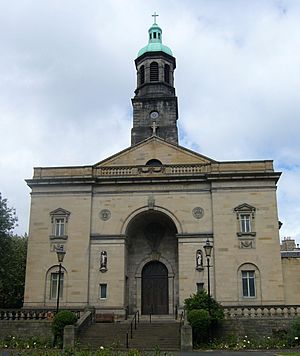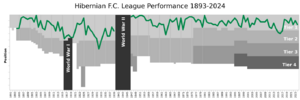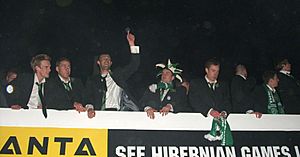History of Hibernian F.C. facts for kids
Hibernian, often called Hibs, is a famous Scottish football club. It was started in 1875. The name 'Hibernian' comes from Hibernia, the old Roman name for Ireland. It also honors the Ancient Order of Hibernians, a group connected to Irish culture.
Hibs has played in the top Scottish football league for almost every season since 1895. They have won the title of Scottish champions four times, with their last win in 1952. Hibs also won the second-tier league six times, most recently in 2017. The club has won the Scottish Cup three times. Their 2016 win was very special, as it ended a 114-year wait! Hibs has also won the Scottish League Cup three times, most recently in 2007.
Contents
How Hibs Started (up to 1875)
In the 1800s, many Irish people moved to Scotland, especially after the Great Famine. Most settled in Glasgow, but some came to Edinburgh. The Cowgate area of Edinburgh was even called Little Ireland because so many Irish people lived there.
St Patrick's Church in the Cowgate had a group called the Catholic Young Men's Society (CYMS). A priest named Canon Edward Joseph Hannan wanted to help the Irish community connect more with Edinburgh. Michael Whelahan suggested that the CYMS should start its own football club.
So, on August 6, 1875, Hibernian F.C. was founded! Canon Hannan became the first manager, and Whelahan was the first captain. This happened during celebrations for Daniel O'Connell, a famous Irish leader.
At first, only members of the CYMS could play for Hibs. Some people thought this made Hibs a "sectarian" club, meaning it was only for one religious group. However, Hibs also played charity matches for other causes. Michael Whelahan once said that for Hibernian, "neither race nor religion were ever a consideration... to help such a worthy cause."
In their early years, Hibs played matches on The Meadows in Edinburgh. It was hard at first because some people didn't want an Irish club in Scottish football. The Scottish Football Association even said they were "catering for Scotsmen, not Irishmen".
But Hibs' rivals, Hearts, helped break down this resistance. Hearts played against Hibs on Christmas Day 1875, even though there were rules against playing Irish clubs. Hearts won that first game 1–0. Thanks to the hard work of Canon Hannan and Whelahan, Hibs was eventually accepted by the football authorities.
Early Success (1878–1887)
Hibs and Hearts quickly became the best teams in Edinburgh. This started their famous rivalry, which is still strong today! They had a big five-game battle for the Edinburgh Cup in 1878.
In 1880, Hibs moved to a new home called Hibernian Park in the Easter Road area. By 1883, Hibs was the top team in Edinburgh football. In 1887, they made history by becoming the first club from the "east coast" of Scotland to win the Scottish Cup. They were only the fifth club overall to do so!
On August 13, 1887, Hibs played Preston North End in a match called the Association football Championship of the World decider. Hibs had just won the Scottish Cup, and Preston was building a very strong team.
Celtic and Changes (1887–1891)
Hibs was the first Scottish club started by Irish Catholic people who had moved to Scotland. Their success inspired others. This led to the creation of other Irish clubs in Scotland, like Dundee Harp, Dundee Hibernian, and Celtic.
Brother Walfrid often invited Hibs to play in Glasgow before Celtic was formed. He saw that Glasgow had a much larger Irish population than Edinburgh. He realized a Glasgow club could help the Irish community there even more. So, in November 1887, Celtic was formed. They played their first game in May 1888, mostly with players borrowed from Hibs.
A big problem for Hibs came from John Glass, who helped fund Celtic. He saw that football was becoming professional in England and knew it would happen in Scotland. Celtic started offering money to Hibs' amateur players. This meant Hibs lost many of their best players, who had helped them win so much.
Because of poor management, Hibs missed a meeting to form the Scottish Football League in 1890. This meant Hibs didn't join the league, while their Edinburgh rivals, Hearts and St Bernard's, did. Not being in the league made it harder for Hibs to find teams to play against. Also, their lease on Hibernian Park ran out. Hibs became homeless and stopped playing for a while in 1891. Their remaining star players moved to Celtic.
Hibs Reborn (1892–1945)
The club was restarted in 1892. They found a new home at a place that would become Easter Road. A big change was that players no longer had to be members of the Catholic Young Men's Society. On February 4, 1893, Hibs played their first match at Easter Road.
Hibs joined the Scottish Football League in the 1893–94 season. They won the first-ever Division Two championship! But strangely, they weren't allowed into Division One for the next season. Instead, Clyde was promoted.
But Hibs didn't give up! They won the Division Two championship again in 1894–95. This was part of what was called the Edinburgh Slam, because Hearts won Division One and St Bernard's won the Scottish Cup that year. Hibs then got enough support from other clubs to be promoted to Division One for the 1895–96 season.
In their first year in Division One, Hibs finished a good third place. They also reached the Scottish Cup final against Hearts. The game was played in Edinburgh, not Glasgow, which was unusual. Hearts won 3–1 in front of 17,000 fans. The next season, a win against Hearts could have given them the league title, but they lost 1–0.
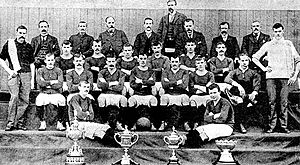
Over the next ten years, Hibs had a good run. They finished fourth or higher every season until 1901. Then, they won the Scottish Cup in 1902 and the league championship in 1903!
After this, Hibs had a tough time for nearly forty years, including during World War I. The "Old Firm" clubs (Celtic and Rangers) started to dominate Scottish football. Hibs only finished third or higher once in the league during this period (in 1925). They were even relegated for the first time in 1931. Hibs did reach three Scottish Cup finals in this time, two of them in the mid-1920s.
The Famous Five (1945–1955)
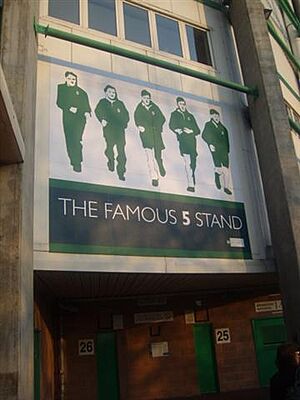
Hibs' most successful time was in the ten years after World War II. A famous group of five forwards, known as The Famous Five, led the team. These players were Gordon Smith, Bobby Johnstone, Lawrie Reilly, Eddie Turnbull, and Willie Ormond.
They helped Hibs win the league championships in 1948, 1951, and 1952. The 1952 championship is still the last time Hibs won the top league title! They also finished second in 1950 and 1953.
The team wasn't as lucky in cup competitions. Their only Scottish Cup final appearance in this period was in 1947, where they lost to Aberdeen. In 1953, Hibs reached the final of the Coronation Cup. This was a special competition between the best teams in England and Scotland to celebrate Queen Elizabeth's coronation. Hibs beat Newcastle United and Tottenham Hotspur but lost 2–0 to Celtic in the final.
Because of their success, Hibs was invited to play in the very first European Cup in 1955–56. Even though they only finished 5th in the league that year, they were chosen! Hibs reached the semi-finals of the European Cup, losing to Stade Reims.
The north stand at Easter Road stadium was named after the Famous Five when it was rebuilt in 1995.
The 1960s
In 1963, Hibs bought Neil Martin from Queen of the South for £7,500 to help the team improve. Martin's goals really helped! On April 1, 1964, Jock Stein became Hibernian's manager. Within months, he led them to win the Summer Cup. People said he was "miles" ahead of others in understanding football.
Hibs didn't qualify for European competitions, but they played Real Madrid in a friendly match at Easter Road and won 2–0! Jock Stein left in March 1965 to manage Celtic. Neil Martin scored 29 goals that season, and Hibs finished 4th in the league. They finished above both Old Firm teams and knocked Rangers out of the Scottish Cup, but lost in the semi-final.
Martin was still at Hibs when they played Valencia in the Fairs Cup. Hibs won 2–0 at home, but lost by the same score in Spain, leading to a play-off game which Hibs lost 3–0. Neil Martin later became the first player to score 100 goals in both the Scottish and English leagues.
Hibs also had an interesting adventure when they played as Toronto City in the United Soccer Association in North America. They finished third in their division in a summer league. Pat Stanton said the league was well-organized, but the long trips were tiring.
Turnbull's Tornadoes (1971–1980)
Another great time for Hibs was in the early 1970s. The team, managed by Eddie Turnbull, was known as Turnbull's Tornadoes. They challenged for the league title, finishing second in 1974 and 1975.
In cup competitions, Hibs won the 1972–73 Scottish League Cup. They also reached the 1972 Scottish Cup Final and won the Drybrough Cup in 1972 and 1973. One of their most famous wins was a 7–0 victory over Hearts at Tynecastle on January 1, 1973. Famous players from this era included Pat Stanton, Alan Gordon, Joe Harper, and John Blackley.
Hibs also brought in some new ideas during this time. In 1977, they became the first Scottish club to have a sponsor's logo on their shirts, advertising Bukta sportswear. At first, TV companies refused to show Hibs' games because of the logo. They eventually agreed that Hibs would wear purple shirts when their games were televised. In 1980, Hibernian was the first Scottish club to install under-soil heating at their stadium.
Towards the end of Eddie Turnbull's time, Hibs reached the Scottish Cup final in 1979. The first game was a draw, and so was the first replay. Hibs finally lost in extra time in the second replay, sadly due to an own goal by Arthur Duncan.
Hearts Takeover Bid (1989–1991)
Even though manager Alex Miller kept Hibs in the top league in the late 1980s, the club was in big financial trouble. In 1990, Hearts chairman Wallace Mercer suggested that Hibs and Hearts should combine to form one big club. He thought this new club could better compete with the Old Firm (Celtic and Rangers).
However, Hibs fans saw this as a hostile takeover. They believed Hearts wanted to continue, but Hibs would disappear. In response, Hibs fans formed a group called Hands off Hibs. They fought to keep the club alive and stop Mercer. Even Hearts' star player, John Robertson, protested the idea.
The campaign worked! A local businessman, Sir Tom Farmer, who owned Kwik Fit, was convinced to buy a controlling share in Hibs. Farmer wasn't a big football fan, but he was persuaded to help because one of his ancestors had helped save Hibs from financial trouble in the 1890s.
Farmer invested some money to help Hibs get back on track. They signed new players like Murdo MacLeod and Keith Wright. As a result, the club won the 1991–92 Scottish League Cup! They beat Rangers in the semi-final and Dunfermline in the final. This period, from the takeover threat to the League Cup win, was even shown in a TV series.
After nearly ten years, Alex Miller was sacked as manager in September 1996. Jim Duffy took over, but his time was difficult. Hibs barely avoided relegation in his first season. When he was sacked in February 1998, Hibs was at the bottom of the league and was later relegated.
Recent History (1998–Present)
1998–2004: Relegation and Quick Promotion
Hibernian was relegated to the First Division at the end of the 1997–98 season. But they quickly won promotion back to the newly formed Scottish Premier League in the 1998–99 season. They won 12 games in a row and were crowned champions of the First Division, finishing 23 points ahead of second place!
When they returned to the top league in 1999–2000, Hibs did well for a newly promoted team, finishing 6th. They also reached the semi-finals of the Scottish Cup, but lost to Aberdeen. At the end of that season, the famous slope on the Easter Road pitch was removed.
In 2000–01, Hibs started great, winning six games in a row in August. They also reached the Scottish Cup Final for the first time in 22 years, but lost 3–0 to Celtic. Hibs finished third in the league, which meant they qualified for the UEFA Cup. A highlight was on October 22, 2000, when Mixu Paatelainen scored three goals in a 6–2 win over city rivals Hearts at Easter Road. A new West Stand was finished for the 2001–02 season.
Hibs played AEK Athens in the UEFA Cup and took them to extra time, but lost 4–3 overall. Manager Alex McLeish left in December for Rangers, and fan favorite Franck Sauzée became the new manager.
Sauzée's time as manager was very tough. Hibs only won one game in three months! They were close to being relegated when Sauzée was sacked in February 2002, after only 69 days. This decision was very controversial.
Bobby Williamson replaced Sauzée in March 2002. Hibs won five of their last nine games, which kept them in the SPL. Williamson's time was known for conceding late goals. A memorable example was on January 2, 2003, when Hibs scored two late goals to lead Hearts 4–2, only for Hearts to score two even later goals to draw 4–4!
Despite mixed results, many exciting young players started to emerge under Williamson, including Garry O’Connor, Derek Riordan, Kevin Thomson, and Scott Brown. These players helped Hibs reach the 2004 Scottish League Cup Final by beating both Celtic and Rangers. But they lost 2–0 to Livingston in the final. Williamson left near the end of the 2003–04 season.
2004–2007: Success under Mowbray and Collins
Tony Mowbray became Hibs manager on May 24, 2004. His appointment was a surprise. Mowbray quickly made it clear he wanted Hibs to play attacking, passing football. Even though his team was young, he wanted them to get good results.
Mowbray's plans worked! Hibs finished 3rd in his first season (2004–05) and qualified for the UEFA Cup. Mowbray won the manager of the year award, and striker Derek Riordan won the young player of the year award. Hibs also reached the semi-final of the Scottish Cup, losing to Dundee United.
In the 2005–06 season, Hibs started very well, winning 10 of their first 14 league games. Some people thought they could challenge for the championship, but Mowbray said it was unlikely because other teams like Rangers, Celtic, and Hearts had much bigger budgets. Highlights included three wins in a row against Rangers and a 2–0 win over Hearts.
Hibs lost to Dnipro Dnipropetrovsk from Ukraine in the UEFA Cup. They also lost badly to Dunfermline in the CIS Cup. Injuries and the sale of Garry O'Connor to Lokomotiv Moscow showed the team didn't have enough depth. After a tough second half of the season, Hibs finished 4th and qualified for the Intertoto Cup. They did well in the Scottish Cup, but lost 0–4 to Hearts in the semi-final.

Mowbray left Hibs in October 2006 to manage West Bromwich Albion. After much talk, John Collins was announced as the new manager on October 31, 2006. Collins resigned on December 20, 2007, after winning the Scottish League Cup during his year in charge.
During Collins' time, Hibs sold more star players, including Kevin Thomson, Scott Brown, and Steven Whittaker. Most went to the Old Firm clubs. These sales greatly improved the club's finances and allowed them to invest in a training ground. However, Hibs kept player wages low. Collins said he resigned because he was frustrated by the lack of money to replace the players who were sold.
Mixu Paatelainen became manager on January 10, 2008. Hibs improved under him and finished in the top half of the SPL for the fourth season in a row. They played in the last Intertoto Cup but lost to IF Elfsborg from Sweden. Paatelainen resigned at the end of the season, saying it was time for a change.
2009–2014: Decline and Relegation
Another former Hibernian player, John Hughes, became the new manager. He made some big signings like Anthony Stokes and Liam Miller. Hibs started the 2009–10 season well. But then, some "unacceptable" performances in early 2010 led to a Scottish Cup defeat and the club falling to fifth place. Towards the end of the season, a 6–6 draw with Motherwell set a record for most goals in an SPL match! A win on the final day meant Hibs finished fourth and qualified for the Europa League.
However, a bad start to the 2010–11 season led to Hughes leaving in October. Colin Calderwood replaced him, but he was also sacked in November 2011.
Pat Fenlon took over from Calderwood. The club avoided relegation in 2011–12 and reached the 2012 Scottish Cup Final, but they lost 5–1 to Hearts. Fenlon largely rebuilt the team after this defeat. This led to a better league position in 2012–13 and the team reaching the 2013 Scottish Cup Final. But they lost 3–0 to league champions Celtic.
Losing the cup final to the league champions meant Hibs qualified for the 2013–14 UEFA Europa League. However, Hibs suffered a Scottish record defeat in Europe, losing 7–0 at home and 9–0 overall against Malmö. Fenlon resigned on November 1 and was replaced by Terry Butcher. A run of 13 games without a win meant Hibs ended up in a relegation play-off. They lost after a penalty shootout against Hamilton Academical, and were relegated.
2014–2017: Life in the Second Tier and Scottish Cup Success
Butcher was sacked in June 2014, and Alan Stubbs became the new manager. The second tier league (Championship) got a lot of attention in 2013–14 because both Hearts and Hibs had been relegated, and Rangers had been promoted from the third tier. Hearts easily won the league and automatic promotion. Hibs finished second, just ahead of Rangers. Both teams entered the promotion playoffs, but Hibs lost to Rangers in the semi-final. Hibs also reached the semi-final of the 2014–15 Scottish Cup, but lost to Falkirk.
In their second season in the Championship, Hibs competed with Rangers for automatic promotion. Hibs also did well in cup competitions, reaching the 2015–16 Scottish League Cup final (lost to Ross County) and progressing in the 2015–16 Scottish Cup. A poor run of league games meant Rangers won the championship. Hibs finished third and again entered the playoffs, but lost to Falkirk in the semi-final.
A week later, Hibs faced Rangers in the 2016 Scottish Cup Final. A goal in injury time by team captain David Gray gave Hibs a 3–2 win! This ended their 114-year wait for the Scottish Cup.
Soon after the cup win, Stubbs left Hibs to manage Rotherham United. He was replaced by Neil Lennon, who led the team to promotion by winning the 2016–17 Scottish Championship. In their first defense of the Scottish Cup in over a century, Hibs reached the semi-finals but lost to Aberdeen.
2017–Present: Return to the Premiership
Hibs performed well in their first season back in the top league, finishing fourth in the 2017–18 Scottish Premiership. They finished fifth in the 2018–19 season, with Paul Heckingbottom becoming manager in February. Heckingbottom was sacked in November 2019 and replaced by Jack Ross.
Hibs finished seventh in the 2019–20 league season, which was cut short by the COVID-19 pandemic. In the next season, they finished third in the league and reached the 2021 Scottish Cup Final, but lost 1–0 to St Johnstone.
Cup Finals
Scottish Cup
Hibs has won the Scottish Cup three times: in 1887, 1902, and 2016. They have reached 15 Scottish Cup Finals in total. Before 2016, they had lost 10 finals in a row!
| Season | Date | Winners | Finalists | Score |
|---|---|---|---|---|
| 1886–87 | 12 February 1887 | Hibernian | Dumbarton | 2–1 |
| 1895–96 | 14 March 1896 | Heart of Midlothian | Hibernian | 3–1 |
| 1901–02 | 26 April 1902 | Hibernian | Celtic | 1–0 |
| 1913–14 | 16 April 1914 | Celtic | Hibernian | 4–1 |
| 1922–23 | 31 March 1923 | Celtic | Hibernian | 1–0 |
| 1923–24 | 19 April 1924 | Airdrieonians | Hibernian | 2–0 |
| 1946–47 | 19 April 1947 | Aberdeen | Hibernian | 2–1 |
| 1957–58 | 26 April 1958 | Clyde | Hibernian | 1–0 |
| 1971–72 | 6 May 1972 | Celtic | Hibernian | 6–1 |
| 1978–79 | 28 May 1979 | Rangers | Hibernian | 3–2 |
| 2000–01 | 26 May 2001 | Celtic | Hibernian | 3–0 |
| 2011–12 | 19 May 2012 | Heart of Midlothian | Hibernian | 5–1 |
| 2012–13 | 26 May 2013 | Celtic | Hibernian | 3–0 |
| 2015–16 | 21 May 2016 | Hibernian | Rangers | 3–2 |
| 2020–21 | 22 May 2021 | St Johnstone | Hibernian | 1–0 |
League Cup
Hibs has won the Scottish League Cup three times: in 1972, 1991, and 2007. The 1972 win was the first time in 70 years that Hibs had won a national cup tournament!
Hibs also won the 1943–44 Southern League Cup. This was a competition played during World War II that was similar to the Scottish League Cup. Hibs won by beating Rangers 6–5 on corner kicks after the final ended in a draw.
| Season | Date | Winners | Finalists | Score |
|---|---|---|---|---|
|
1950–51 |
28 October 1950 |
Hibernian |
3–0 |
|
|
1968–69 |
5 April 1969 |
Hibernian |
6–2 |
|
|
1972–73 |
9 December 1972 |
Hibernian |
Celtic |
2–1 |
|
1974–75 |
26 October 1974 |
Celtic |
Hibernian |
6–3 |
|
1985–86 |
27 October 1985 |
Hibernian |
3–0 |
|
|
1991–92 |
27 October 1991 |
Hibernian |
2–0 |
|
|
1993–94 |
24 October 1993 |
Hibernian |
2–1 |
|
|
2003–04 |
14 March 2004 |
Hibernian |
2–0 |
|
|
2006–07 |
18 March 2007 |
Hibernian |
5–1 |
|
|
2015–16 |
13 March 2016 |
Hibernian |
2–1 |
Images for kids
-
John Glass, former Celtic president


